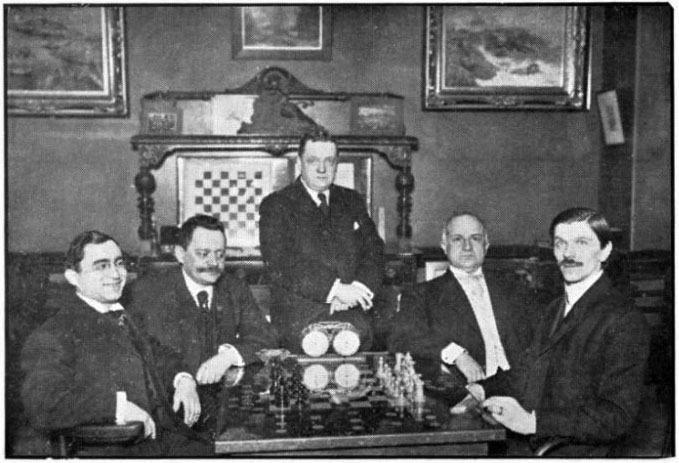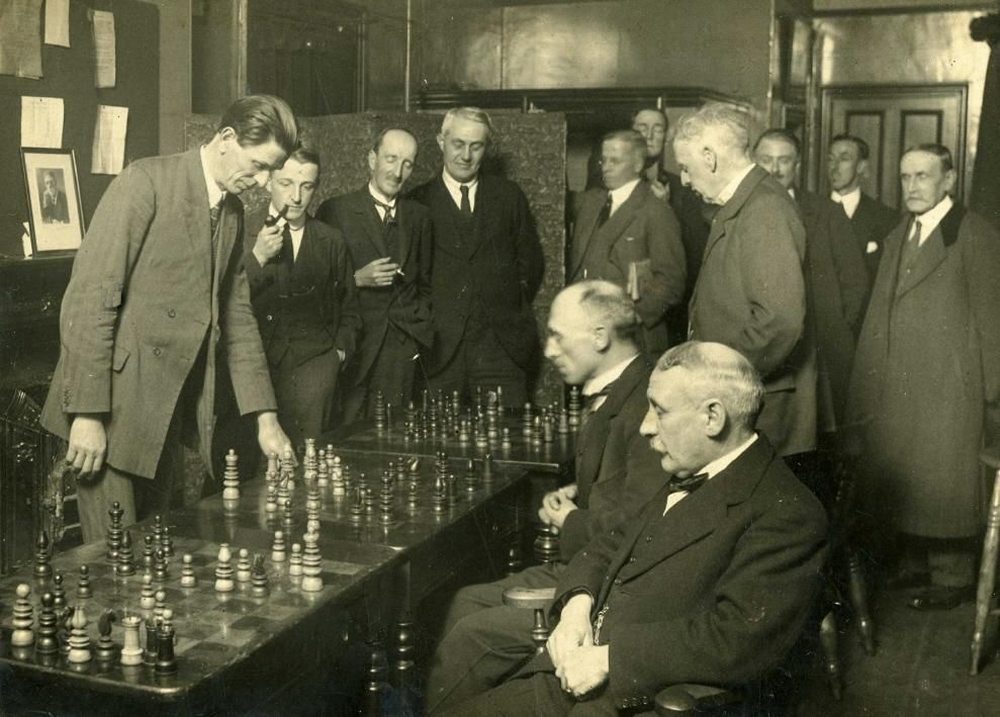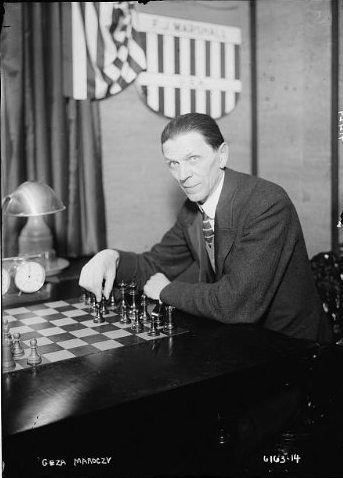Nearly a challenger
The Hungarian Geza Maroczy was one of the best players in the world at the beginning of the 20th century. Statistician Jeff Sonas, in his retrospectively calculated world rankings even sees Maroczy as number one in the world between 1904 and 1907. Maroczy did indeed have a number of brilliant tournament successes. He shared 3rd place at the tournament in Paris 1900, shared 1st place in Munich 1900, shared 1st place in Monte Carlo in the same year, finished third in Monte Carlo in 1903, winner in Monte Carlo in 1904, won the tournament in Ostend 1905, shared 1st place in Barmen in 1905 and second place in Ostend in 1906.
In addition to Tarrasch, Emanuel Lasker saw Maroczy as a worthy challenger. And in 1906 the two masters then negotiated very concretely about a possible World Championship match.

Consultation chess at the Manhattan Chess Club 1906:
(L to R) H.M. Phillips, G.H. Koehler, R.W. Ferguson, P.J.Saulson, Geza Maroczy
Geza Maroczy traveled to the United States in February 1906, went on a simultaneous tour there and met Lasker in New York in April 1906. The general conditions for a competition for the World Championship were soon agreed. On the evening of April 6th, the founding of the Rice Chess Club was celebrated together in Café Boulevard on 2nd Avenue in Manhattan. Frank James Marshall and Jose Raul Capablanca were among the guests at the event. As part of the celebration, Lasker and Maroczy then announced their plans, for which an organizer had to be found. The match should take place in Europe and the USA. A winner-take-all prize fund of of USD $2,000 was agreed. Messrs. Isaac L. Rice, Ponce, Aristides Martinez, Rothschild and von Trebitsch have been appointed to the arbitration panel. Both players were expected to deposit $500 as a "penitence" guarantee in the event of withdrawal. Maroczy wanted to take care of the organization of the competition in Europe, Lasker did the same for the USA half.

Maroczy giving a simultaneous
Maroczy then left the US earlier than planned to still be able to take part in the tournament in Ostend in 1906. While Lasker followed through with his deposit on schedule, Maroczy failed to do so, but announced that it would soon comply. Lasker then received a letter from the Vienna Chess Club at the end of June 1906, declaring its willingness to host the competition, but only for the entire competition. Lasker agreed in principle, but not with some details of the competition conditions. While Lasker was negotiating with the Viennese, Maroczy had disappeared. In September 1906, Maroczy reappeared and told the Vienna Chess Club that he could not play the 1906 competition, but that he would be ready to play the following year. If Lasker insisted, he would forfeit his deposit. Lasker didn't insist.
Shortly after Maroczy's cancellation, on September 12, 1906, Marshall challenged the world champion. The competition between Lasker and Marshall took place in early 1907 and went very badly for Marshall. Lasker won eight of 15 games, Marshall none.
Maroczy later explained his cancellation by saying that Lasker did not agree to the terms offered by the Vienna Chess Club. Lasker suspected, however, that Maroczy could not raise the guaranteed amount.
Geza Maroczy was born on March 3rd, 1870 in Szeged. His tournament career began in 1894, and in 1895 he took part in the main tournament in Hastings. From the same year, a series of matches against the Hungarian master Rudolf Charousek, who died so early, have survived, in which Maroczy prevailed. Geza Maroczy also played correspondence chess.
Click or tap the second game in the list to switch
In 1896, Maroczy then took part in the international championship tournament in Nuremberg and already took second place behind Emanuel Lasker and ahead of the rest of the world elite of the time: Tarrasch, Pillsbury, Janowsky, and Steinitz, to name just a few. Maroczy was now part of the regular roster of the top tournaments of the day and performed brilliantly.
In 1908, Maroczy, who was no longer the youngest around and, at 38, retired from tournament chess to take a position as an auditor. In 1911, he still participated in the famous tournament in San Sebastian, but without much success.
After the end of the First World War, there was a communist revolution in Hungary in March 1919. A Hungarian-Soviet republic was proclaimed, but it existed for only 133 days. Maroczy lost his job in the wake of the unrest and inevitably returned to tournament chess. In search of reasonably secure political and economic conditions, Maroczy was temporarily in the Netherlands — one of the few countries that avoided financial ruin during the war — then in the United States and in England.

Marozcy (left) among other illustrious colleagues
In the Netherlands, none other than Max Euwe became Maroczy's student.
Though Maroczy did not succeed in becoming world champion, his student Euwe later accomplished the feat. Maroczy, at least 65 years old, was Euwe's second in his competition against Alekhine in 1935. And another Maroczy student also became world champion; during his time in England, Maroczy also regularly trained with Vera Menchik.
After a seven-year exile, he returned to Hungary. Maroczy had probably passed its zenith after the First World War, but he continued to regularly participate in tournaments after 1920 and played quite well with the following players there at eye level.
He was also strong enough to represent Hungary at the Chess Olympiads in London in 1927, Hamburg in 1930, Folkstone in 1933 and in Munich in 1936 (not recognized). Maroczy also took part in the Hungarian National Championship of 1932.

Geza Maroczy | Photo: Wikipedia
In 1931, at the tournament in Bled, a dispute with Aaron Nimzowitsch almost led to a potentially fatal argument. As a result of the dispute, Maroczy, an otherwise very peaceful person, challenged Nimzowitsch to a gun duel. Such duels were quite common in the Austro-Hungarian monarchy before the First World War as a way to settle disputes. After the war, however, more progressive solutions were adopted.
Nimzowitsch declined the offer, which made Maroczy feel like a moral winner. Hans Kmoch, a witness to the argument, suspected that the peaceful Maroczy would not have known which end of the pistol the bullet came from. The pair's duel on the board was won by Nimzowitsch with a score of 1½:½.
In the 1940s, Geza Maroczy had to witness another world war and a radical change in the political conditions in his home country of Hungary. Maroczy had a difficult time in Budapest. There was famine and people often had to spend days and nights in shelters.
After the Second World War, Maroczy, now over 75, tried to emigrate to the Netherlands or the United States with his wife, but to no avail. After 1947, only two games have survived that Maroczy played at a tournament in Baarn (Netherlands). Maroczy returned to Hungary with his wife. He died in Budapest on May 30, 1951, at 81 years old.

Maroczy's gravestone | Photo: Dr. Varga
After his death, Maroczy made headlines again. Dr. Wolfgang Eisenbeiss, chess enthusiast and president of the Swiss Society for Parapsychology, arranged a long-distance game between Victor Korchnoi and the dead "Geza Maroczy". Korchnoi, who had made himself available for the experiment, had wished for Capablanca, Keres or Maroczy as opponents. Capablanca and Keres were evidently not reachable in the hereafter but Maroczy was available.
The game started on June 15th, 1985 and was written down on paper by the medium. First Korchnoi indicated his move, which was also carried out on a board, then the medium fell into a trance and then wrote down the response from Maroczy and carried it out on the board. The game was not played in one sitting, but after long interruptions it ended in 1991. The notation has been preserved.
Translation from German: Macauley Peterson
Links
.jpeg)



























